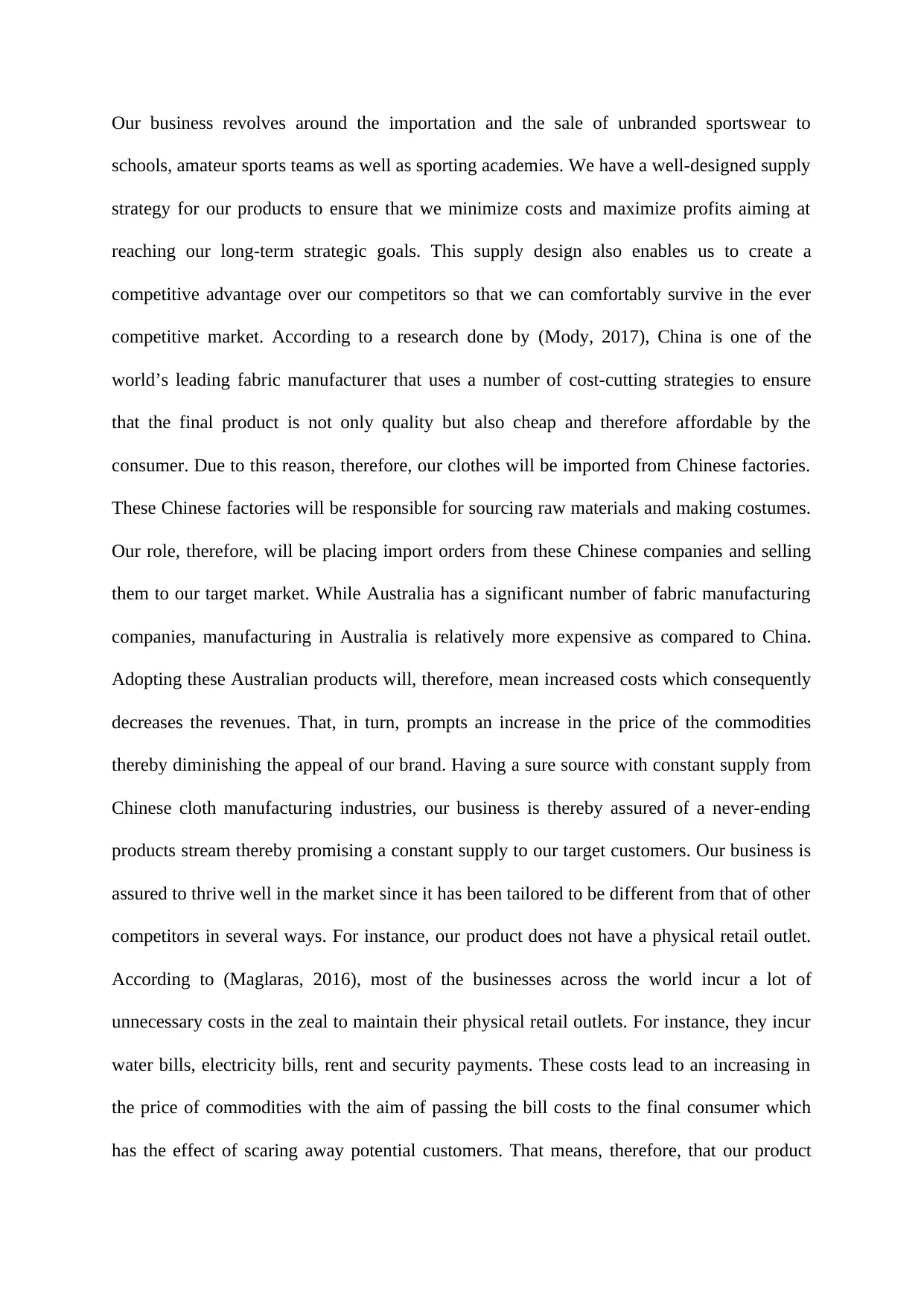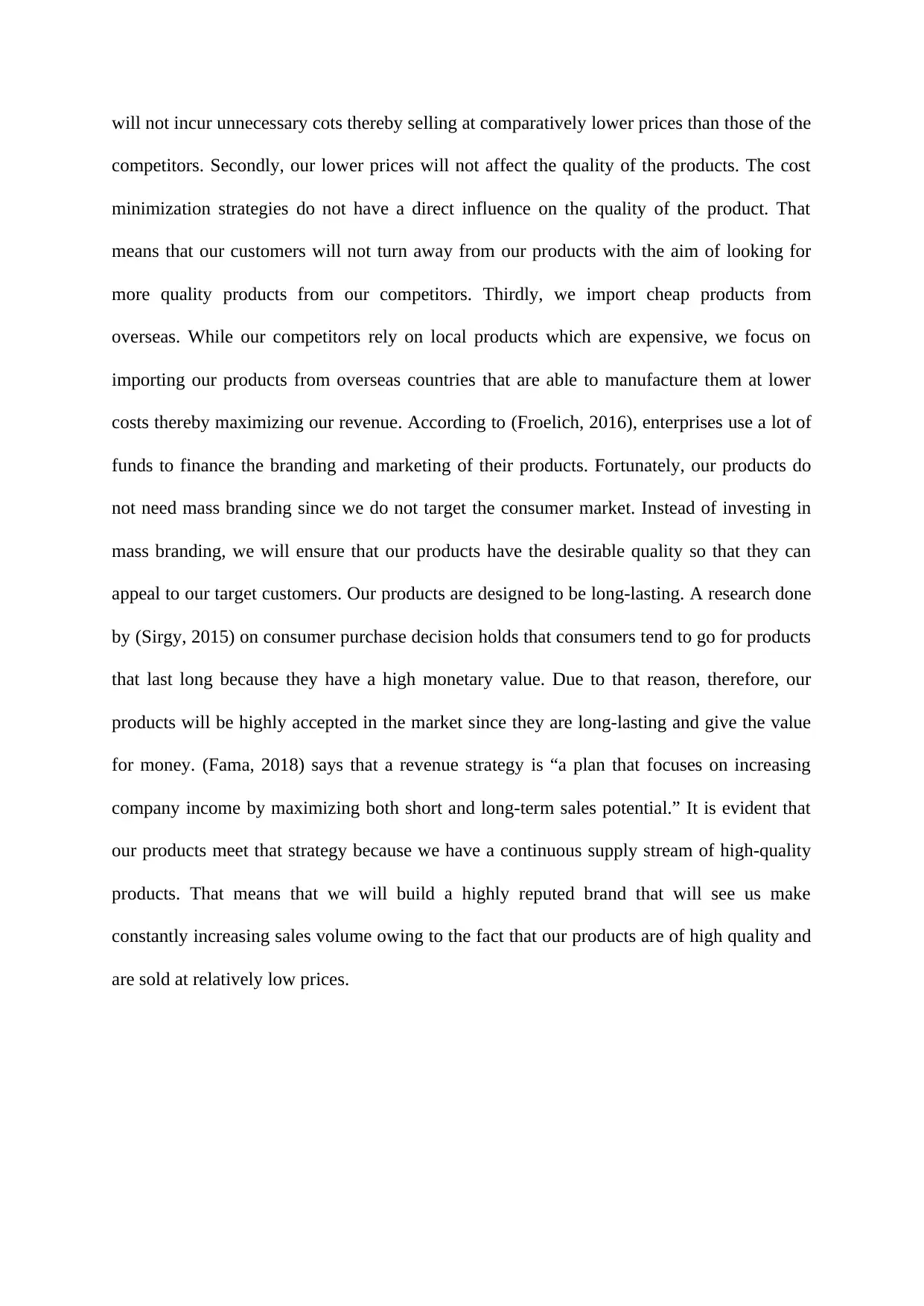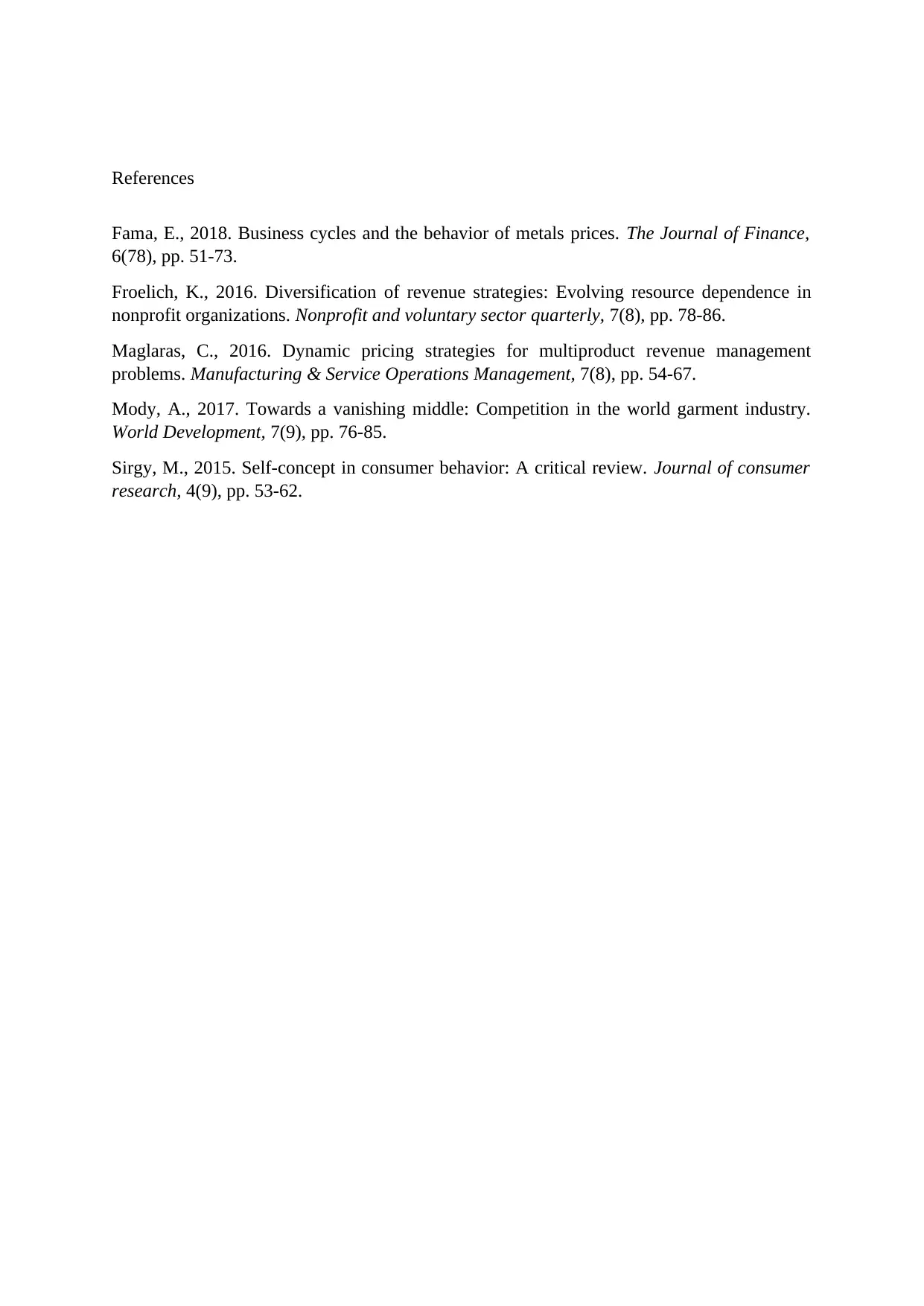ACCG250 - Fitness Factory: Revenue Strategy for Sportswear Sales
VerifiedAdded on 2023/04/21
|3
|891
|233
Report
AI Summary
This report outlines a revenue strategy for a sportswear business named Fitness Factory, focusing on importing and selling unbranded sportswear to schools, amateur sports teams, and sporting academies. The strategy emphasizes cost minimization through importing from Chinese factories, avoiding physical retail outlets to reduce overhead, and foregoing mass branding in favor of quality products. By ensuring a consistent supply of high-quality, affordable products, Fitness Factory aims to establish a strong brand reputation and achieve continuous sales growth. The report references academic research to support the chosen strategies, highlighting the importance of long-lasting products and efficient revenue management.

Our business revolves around the importation and the sale of unbranded sportswear to
schools, amateur sports teams as well as sporting academies. We have a well-designed supply
strategy for our products to ensure that we minimize costs and maximize profits aiming at
reaching our long-term strategic goals. This supply design also enables us to create a
competitive advantage over our competitors so that we can comfortably survive in the ever
competitive market. According to a research done by (Mody, 2017), China is one of the
world’s leading fabric manufacturer that uses a number of cost-cutting strategies to ensure
that the final product is not only quality but also cheap and therefore affordable by the
consumer. Due to this reason, therefore, our clothes will be imported from Chinese factories.
These Chinese factories will be responsible for sourcing raw materials and making costumes.
Our role, therefore, will be placing import orders from these Chinese companies and selling
them to our target market. While Australia has a significant number of fabric manufacturing
companies, manufacturing in Australia is relatively more expensive as compared to China.
Adopting these Australian products will, therefore, mean increased costs which consequently
decreases the revenues. That, in turn, prompts an increase in the price of the commodities
thereby diminishing the appeal of our brand. Having a sure source with constant supply from
Chinese cloth manufacturing industries, our business is thereby assured of a never-ending
products stream thereby promising a constant supply to our target customers. Our business is
assured to thrive well in the market since it has been tailored to be different from that of other
competitors in several ways. For instance, our product does not have a physical retail outlet.
According to (Maglaras, 2016), most of the businesses across the world incur a lot of
unnecessary costs in the zeal to maintain their physical retail outlets. For instance, they incur
water bills, electricity bills, rent and security payments. These costs lead to an increasing in
the price of commodities with the aim of passing the bill costs to the final consumer which
has the effect of scaring away potential customers. That means, therefore, that our product
schools, amateur sports teams as well as sporting academies. We have a well-designed supply
strategy for our products to ensure that we minimize costs and maximize profits aiming at
reaching our long-term strategic goals. This supply design also enables us to create a
competitive advantage over our competitors so that we can comfortably survive in the ever
competitive market. According to a research done by (Mody, 2017), China is one of the
world’s leading fabric manufacturer that uses a number of cost-cutting strategies to ensure
that the final product is not only quality but also cheap and therefore affordable by the
consumer. Due to this reason, therefore, our clothes will be imported from Chinese factories.
These Chinese factories will be responsible for sourcing raw materials and making costumes.
Our role, therefore, will be placing import orders from these Chinese companies and selling
them to our target market. While Australia has a significant number of fabric manufacturing
companies, manufacturing in Australia is relatively more expensive as compared to China.
Adopting these Australian products will, therefore, mean increased costs which consequently
decreases the revenues. That, in turn, prompts an increase in the price of the commodities
thereby diminishing the appeal of our brand. Having a sure source with constant supply from
Chinese cloth manufacturing industries, our business is thereby assured of a never-ending
products stream thereby promising a constant supply to our target customers. Our business is
assured to thrive well in the market since it has been tailored to be different from that of other
competitors in several ways. For instance, our product does not have a physical retail outlet.
According to (Maglaras, 2016), most of the businesses across the world incur a lot of
unnecessary costs in the zeal to maintain their physical retail outlets. For instance, they incur
water bills, electricity bills, rent and security payments. These costs lead to an increasing in
the price of commodities with the aim of passing the bill costs to the final consumer which
has the effect of scaring away potential customers. That means, therefore, that our product
Paraphrase This Document
Need a fresh take? Get an instant paraphrase of this document with our AI Paraphraser

will not incur unnecessary cots thereby selling at comparatively lower prices than those of the
competitors. Secondly, our lower prices will not affect the quality of the products. The cost
minimization strategies do not have a direct influence on the quality of the product. That
means that our customers will not turn away from our products with the aim of looking for
more quality products from our competitors. Thirdly, we import cheap products from
overseas. While our competitors rely on local products which are expensive, we focus on
importing our products from overseas countries that are able to manufacture them at lower
costs thereby maximizing our revenue. According to (Froelich, 2016), enterprises use a lot of
funds to finance the branding and marketing of their products. Fortunately, our products do
not need mass branding since we do not target the consumer market. Instead of investing in
mass branding, we will ensure that our products have the desirable quality so that they can
appeal to our target customers. Our products are designed to be long-lasting. A research done
by (Sirgy, 2015) on consumer purchase decision holds that consumers tend to go for products
that last long because they have a high monetary value. Due to that reason, therefore, our
products will be highly accepted in the market since they are long-lasting and give the value
for money. (Fama, 2018) says that a revenue strategy is “a plan that focuses on increasing
company income by maximizing both short and long-term sales potential.” It is evident that
our products meet that strategy because we have a continuous supply stream of high-quality
products. That means that we will build a highly reputed brand that will see us make
constantly increasing sales volume owing to the fact that our products are of high quality and
are sold at relatively low prices.
competitors. Secondly, our lower prices will not affect the quality of the products. The cost
minimization strategies do not have a direct influence on the quality of the product. That
means that our customers will not turn away from our products with the aim of looking for
more quality products from our competitors. Thirdly, we import cheap products from
overseas. While our competitors rely on local products which are expensive, we focus on
importing our products from overseas countries that are able to manufacture them at lower
costs thereby maximizing our revenue. According to (Froelich, 2016), enterprises use a lot of
funds to finance the branding and marketing of their products. Fortunately, our products do
not need mass branding since we do not target the consumer market. Instead of investing in
mass branding, we will ensure that our products have the desirable quality so that they can
appeal to our target customers. Our products are designed to be long-lasting. A research done
by (Sirgy, 2015) on consumer purchase decision holds that consumers tend to go for products
that last long because they have a high monetary value. Due to that reason, therefore, our
products will be highly accepted in the market since they are long-lasting and give the value
for money. (Fama, 2018) says that a revenue strategy is “a plan that focuses on increasing
company income by maximizing both short and long-term sales potential.” It is evident that
our products meet that strategy because we have a continuous supply stream of high-quality
products. That means that we will build a highly reputed brand that will see us make
constantly increasing sales volume owing to the fact that our products are of high quality and
are sold at relatively low prices.

References
Fama, E., 2018. Business cycles and the behavior of metals prices. The Journal of Finance,
6(78), pp. 51-73.
Froelich, K., 2016. Diversification of revenue strategies: Evolving resource dependence in
nonprofit organizations. Nonprofit and voluntary sector quarterly, 7(8), pp. 78-86.
Maglaras, C., 2016. Dynamic pricing strategies for multiproduct revenue management
problems. Manufacturing & Service Operations Management, 7(8), pp. 54-67.
Mody, A., 2017. Towards a vanishing middle: Competition in the world garment industry.
World Development, 7(9), pp. 76-85.
Sirgy, M., 2015. Self-concept in consumer behavior: A critical review. Journal of consumer
research, 4(9), pp. 53-62.
Fama, E., 2018. Business cycles and the behavior of metals prices. The Journal of Finance,
6(78), pp. 51-73.
Froelich, K., 2016. Diversification of revenue strategies: Evolving resource dependence in
nonprofit organizations. Nonprofit and voluntary sector quarterly, 7(8), pp. 78-86.
Maglaras, C., 2016. Dynamic pricing strategies for multiproduct revenue management
problems. Manufacturing & Service Operations Management, 7(8), pp. 54-67.
Mody, A., 2017. Towards a vanishing middle: Competition in the world garment industry.
World Development, 7(9), pp. 76-85.
Sirgy, M., 2015. Self-concept in consumer behavior: A critical review. Journal of consumer
research, 4(9), pp. 53-62.
⊘ This is a preview!⊘
Do you want full access?
Subscribe today to unlock all pages.

Trusted by 1+ million students worldwide
1 out of 3
Related Documents
Your All-in-One AI-Powered Toolkit for Academic Success.
+13062052269
info@desklib.com
Available 24*7 on WhatsApp / Email
![[object Object]](/_next/static/media/star-bottom.7253800d.svg)
Unlock your academic potential
Copyright © 2020–2025 A2Z Services. All Rights Reserved. Developed and managed by ZUCOL.





